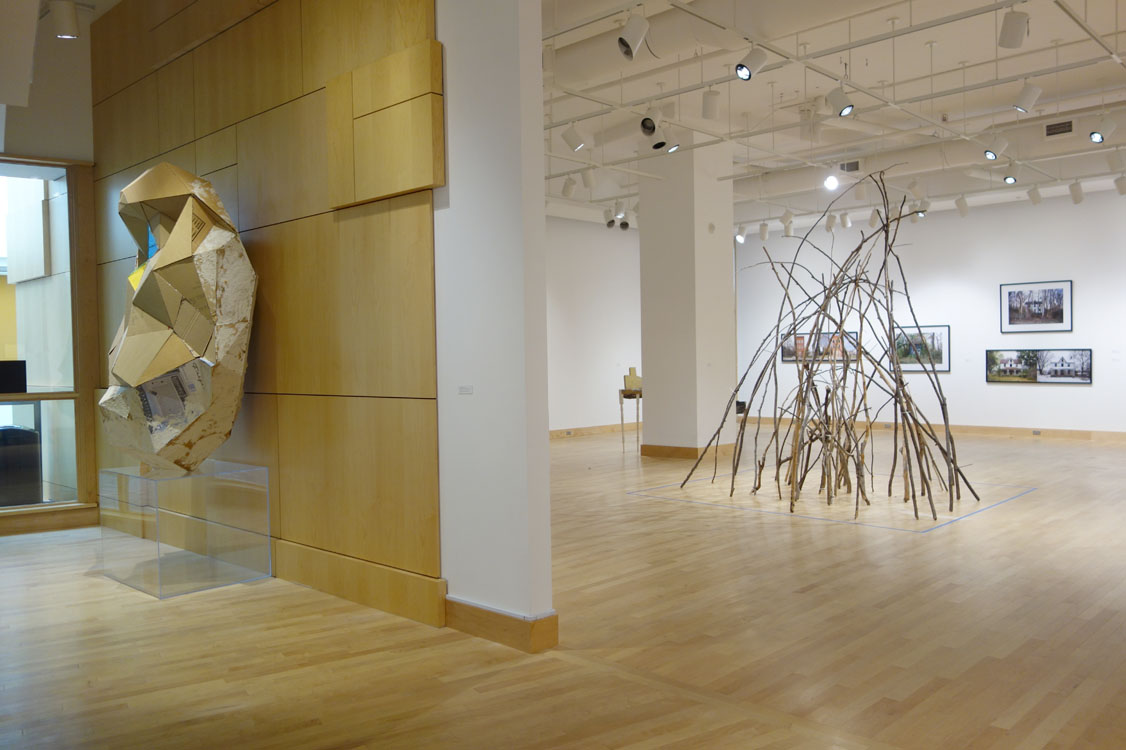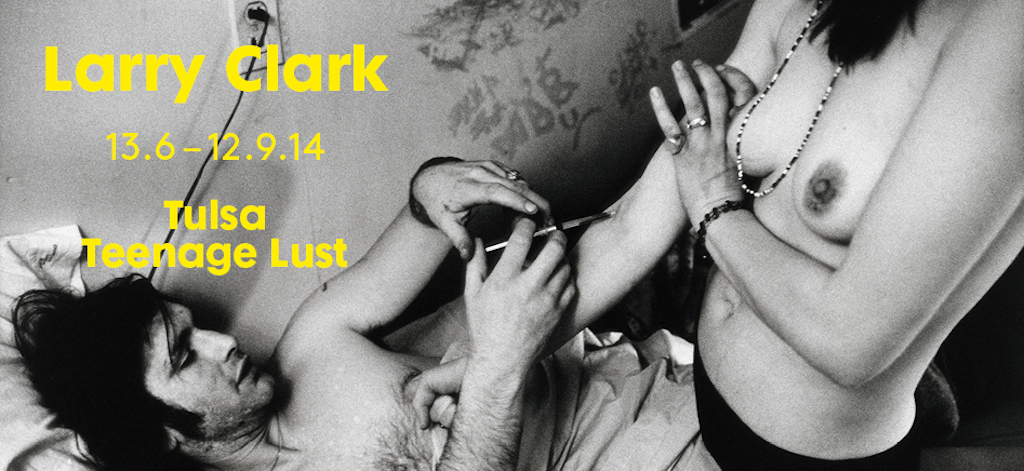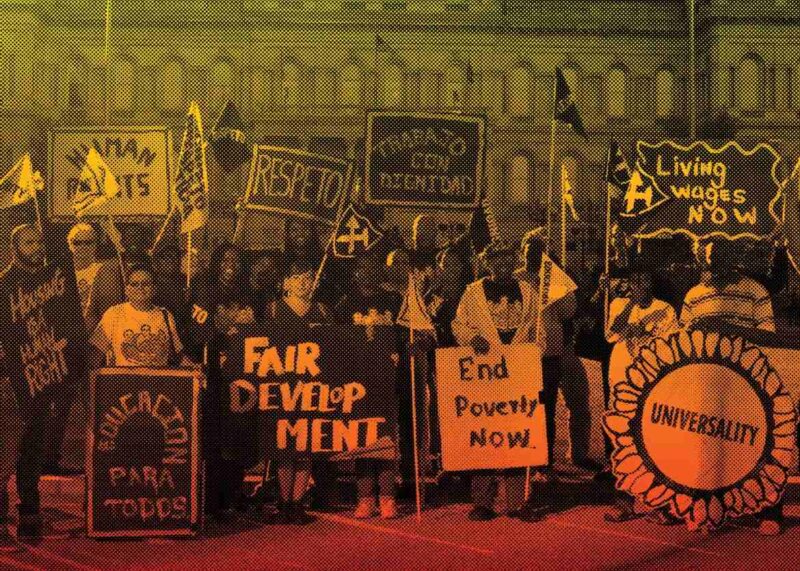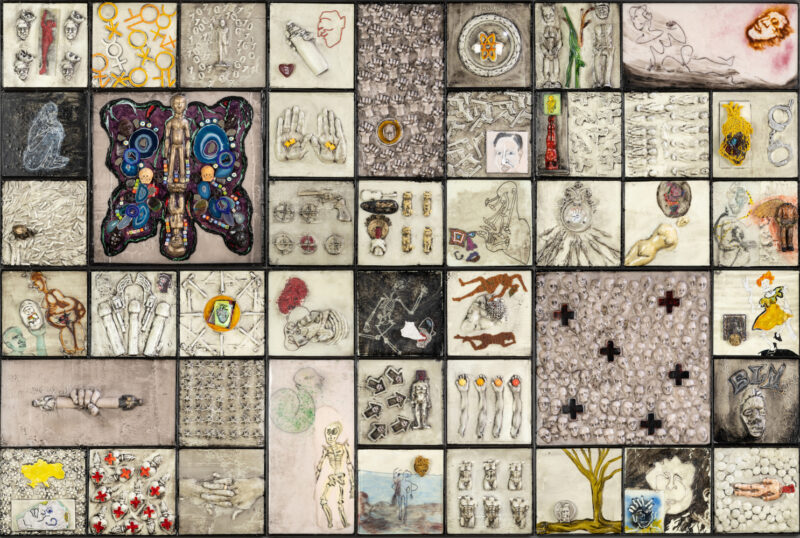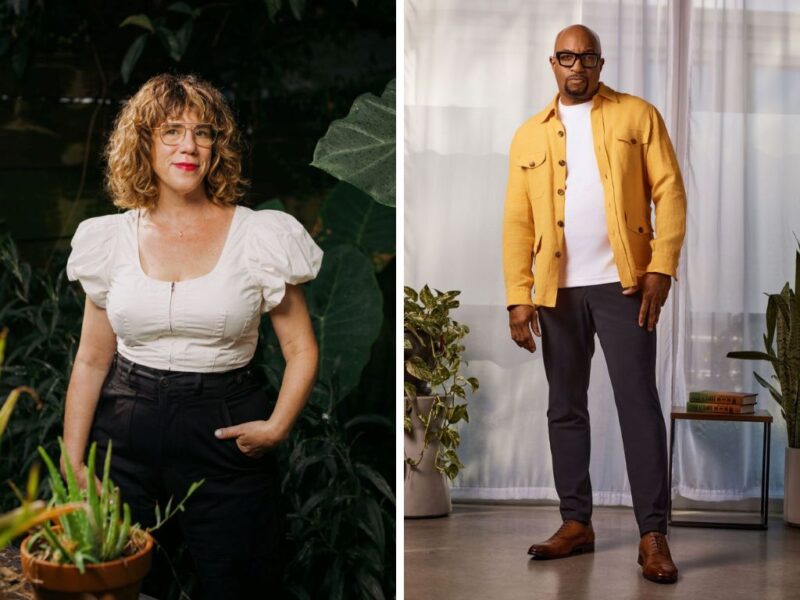Anna Fine Foer Reviews Fiber Options: Material Explorations, A Nationally Juried Exhibition at The Maryland Federation of Art
The opening reception of this national juried exhibit was not crowded, so Juror Aaron McIntosh invited us to walk around and look at each award-winning textile and discuss it. This was refreshing, a juror assuming the role of an educator, and it should happen more often. Kudos to Aaron McIntosh.
McIntosh remark’s delineated the “threads“ that were present in much of the selected work: bodily references, the material as metaphor and commentary on virtual connectivity. He explained a need to explore psychological depths as “a space of interiority” and referenced computer systems, codes and many types of social networking platforms. There was a strong connection between aspects of social networking and traditional/real time/real space meeting places where hours and hours are (were) spent stitching and talking. The quilting bee now has migrated to a virtual space.
Labor intensive textile techniques; embroidery, cross-stitch and weaving; real, tactile, domestic and familiar “craft” forms reflect back our dependence on cyber space connections.
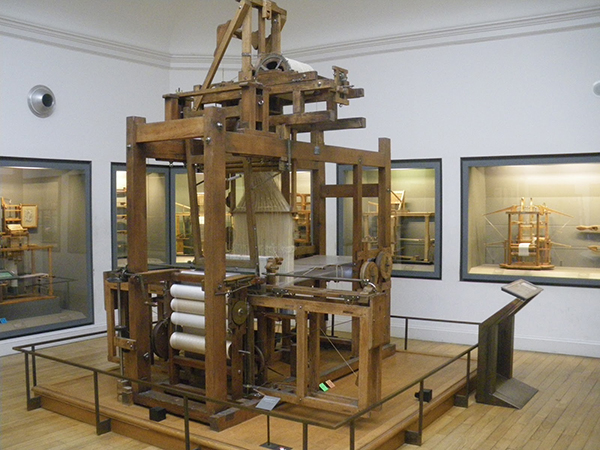
The earliest form of a ‘computer’ was a Jacquard loom circa 1800 but earlier examples were developed nearly 75 years earlier. The Jacquard head used replaceable punched cards to control a sequence of operations. It is considered an important step in the history of computing hardware. The ability to change the pattern of the loom’s weave by simply changing cards was an important conceptual precursor to the development of computer programminig and data entry. It makes perfect sense to exploit textile techniques to reference a computer’s present day abilities from a conceptual point of view, due to their shared history.
The best example of the self-awareness of where it all began (as far as computers) is Liz Ensz’s Overshot Draft Study #1. Strapping tape and graphite on paper portray a weaving pattern, Overshot is a type of weave often seen on American coverlets. Her work presents an interaction between high brow and low brow materials used to make art and brings up all to familiar arguments (especially familiar to textile artists) about what art can and cannot be.
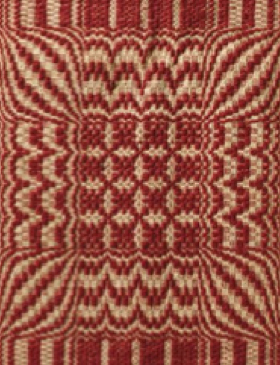
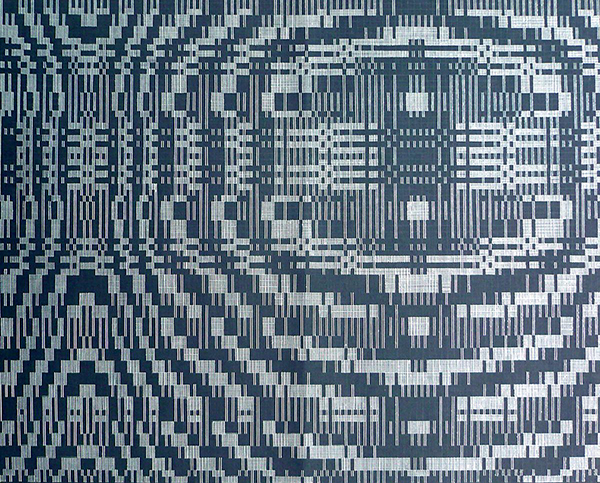
Leigh Courtney Suggs’ You/Me Him/Her Her/Us Him/Me Us/You and I Should/Shouldn’t Have both reference textile history. She received an Honorable Mention for her entries. Of most interest are her knotted works that are like rope ladders or necklaces. They also refer to Peruvian knotted strings; quipu that served as counting and memory devices and can also be considered early computers. The label lists the materials used as paper and wood, which was difficult to discern
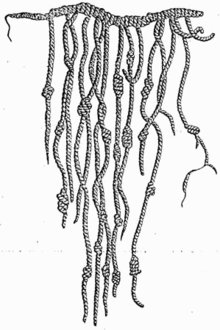
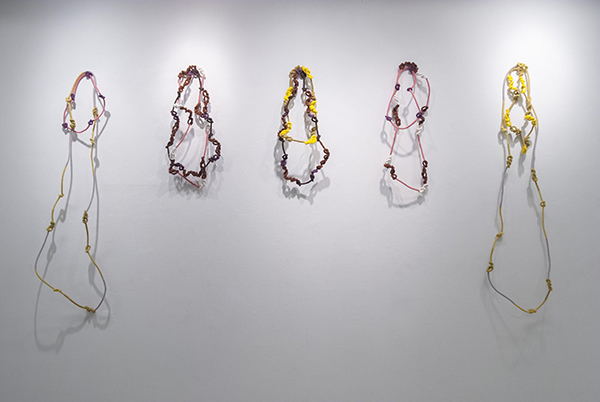
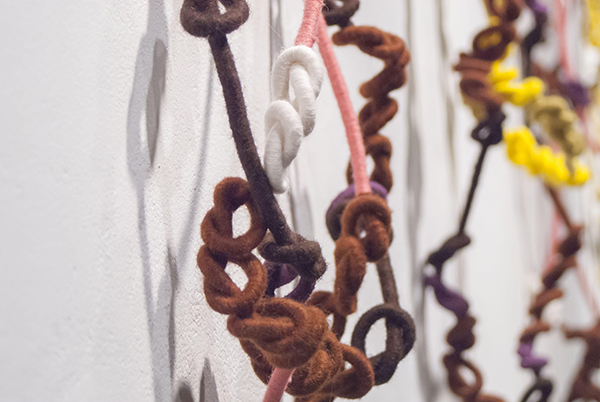
Her installation I Should/Shouldn’t Have was not as interesting (although well-crafted) because utilizes a more common strategy and is derivative of Sheila Hicks’s work. The small loops at the top became large loops at the bottom worked well. It was a wise decision that these two, large works were not installed next to each other, which would have diminished their impact.
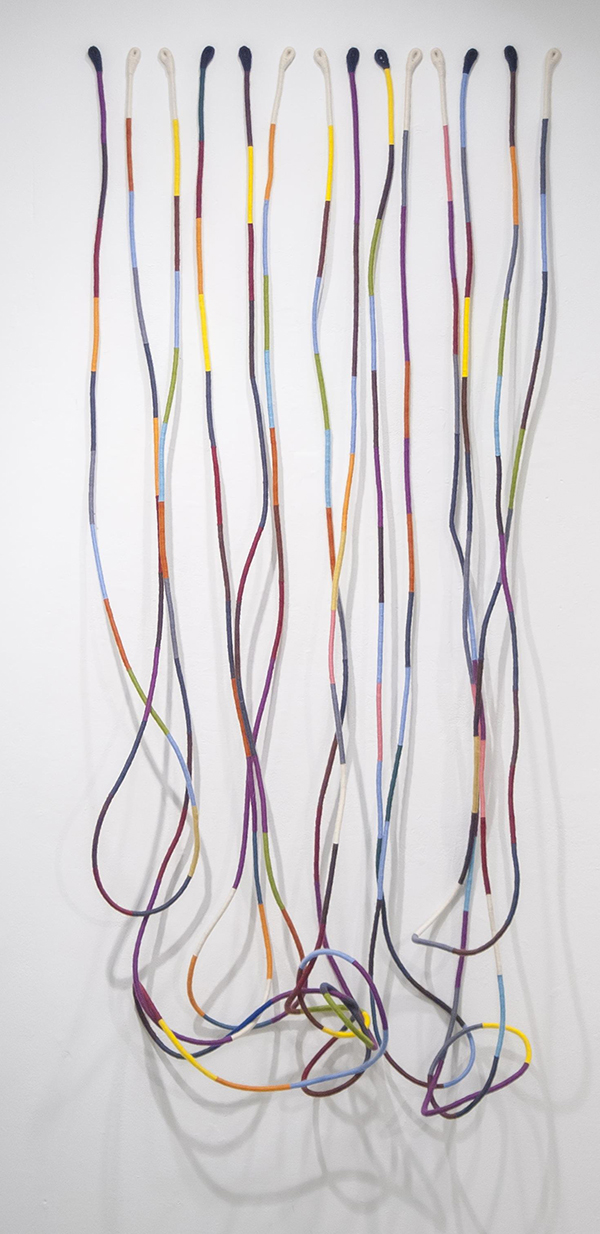
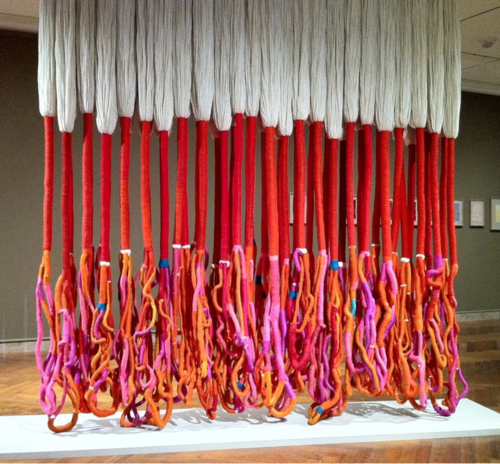
A good example of fiber referencing computer imagery is Nancy Bardach’s Defragging-A Time Lapse View. The minimalist imagery and expertly done patchwork quilting explore the defragging process, while at the same reminiscent of Mondrian’s paintings.
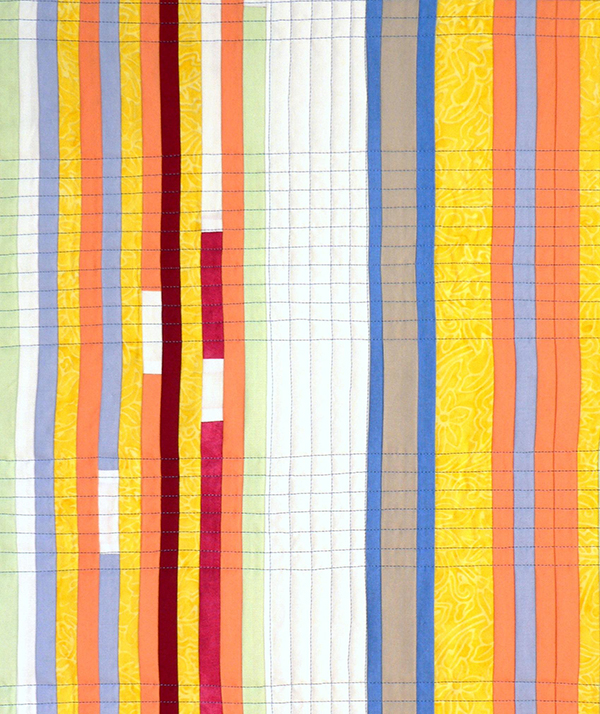
Portrait by April Camlin (a Fiber student at MICA) is a Jacquard woven double cloth. Camlin pixelated the image as far as possible to abstract this double portrait to the point where the pixels become the image, exploiting the interplay of texture and weaving patterns.
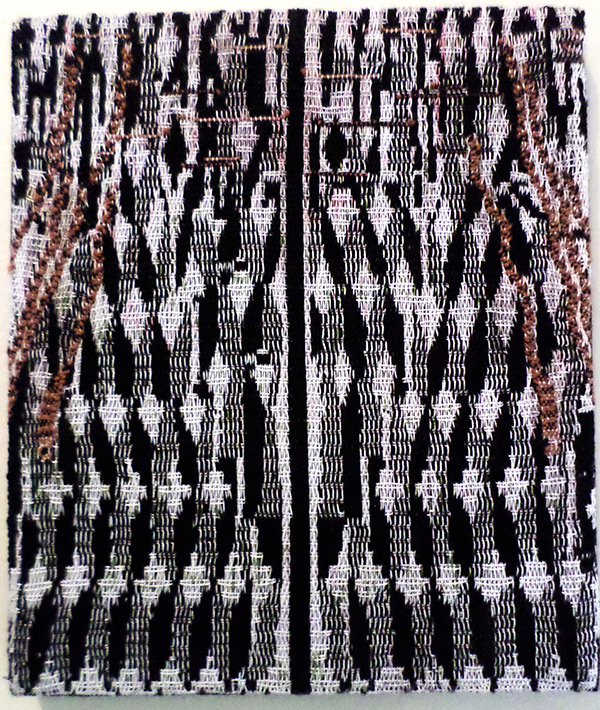
Another weaving by Liz Ensz, Tire Stack Herringbone (hand woven Jacquard, cotton and polyester) serves as a meta image: it is a weaving about weaving and includes an insiders’ story. Its herringbone pattern also depicts tire tracks, raising environmental/societal/transportation concerns while being beautiful at the same time. In this reviewer’s opinion, she deserved the Best in Show award because her work is the most intelligent and well crafted of the group, and evocative in a quiet, subtle, and elegant way.
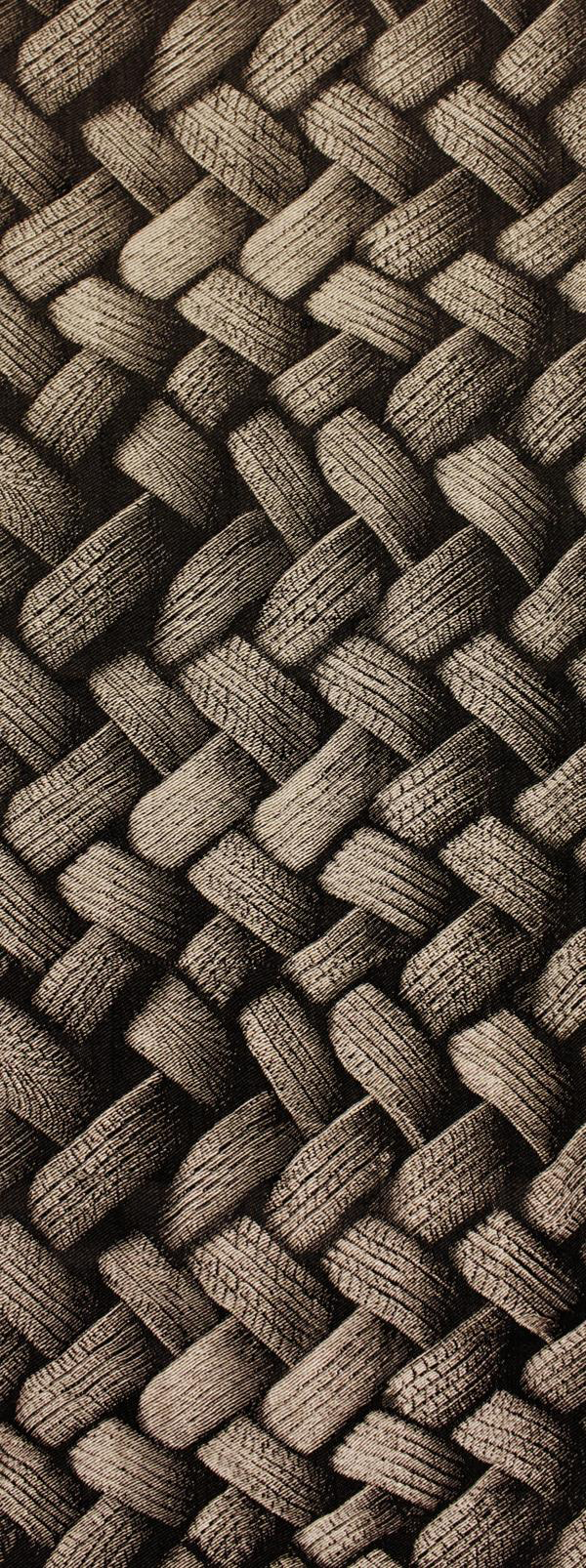
Colleen Toutan Merrill’s 7 Clicks on Twitter, embroidered silk on linen, is a labor-intensive picture of her (or someone else’s?) twitter feed. Her technique furthers comments about society and connectivity by illustrating, in a very time consuming process, a twitter feed, which is the epitome of time not spent to convey a message.

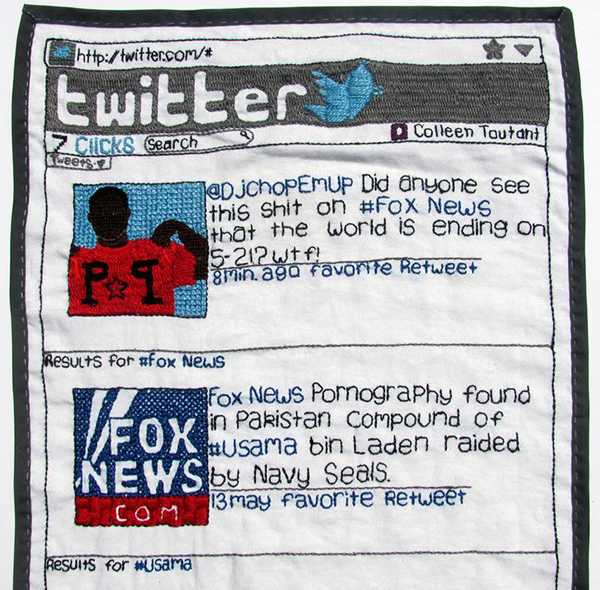
Her other embroidery Google Map of My Social Network is a great idea and especially significant for those of us who are drawn to maps, but unfortunately the installation is unprofessional. It hangs from the top corners and sags in the middle. This detracts from her otherwise good craftsmanship and attention to detail. How is it possible that a textile artist who has the capability to craft excellent work, take a successful photo so that the work is accepted in the exhibition, and ships it to the venue without damaging the work has nearly zero regard for installation? She should have taken the time to mount this textile on a padded mount, so that the piece would hang straighter, allowing the viewer to focus on the details and not on the irregular shaped edges.

Rebecca Mushtare’s Matrlineage illustrates QR (Quick Response) codes. A QR code consists of black modules (square dots) arranged in a square grid on a white background, which can be read by an imaging device (such as a camera) and processed to connect to a link for the product The required data are then extracted from patterns present in both horizontal and vertical components of the image.
Six intimate frames illustrate a QR code, each one a different technique; cross-stitch, patchwork, woven ribbons, loom woven beading, printing and embroidery and felt. The cross-stitch is the most detailed in the group. It would have been more interesting to see different representations of a QR code in cross-stitch, or have real QR codes that took us to cross-stitch patterning, rather than give us a quick guide to techniques and materials.

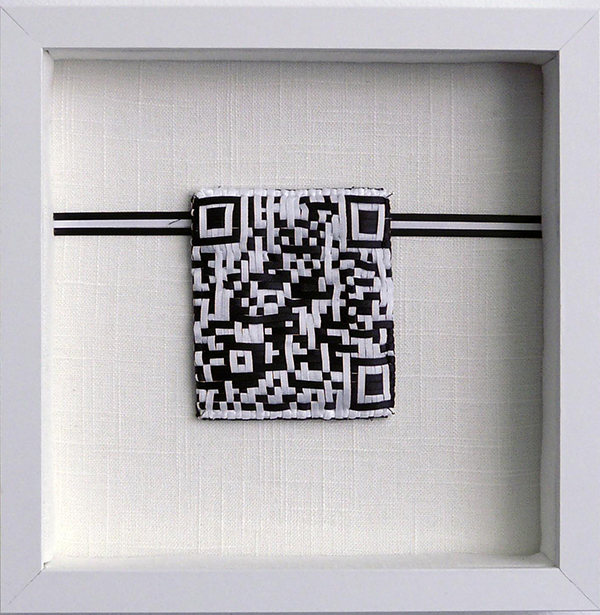
Do Not Remove by Kass McGowan is a quilted patchwork of the warning labels and mattresses that many of us wonder about. How many times have we thought the police would show up in our room if we removed one of those labels? The pink satin edging is reminiscent of traditional blankets and is a favorite for children to rub.
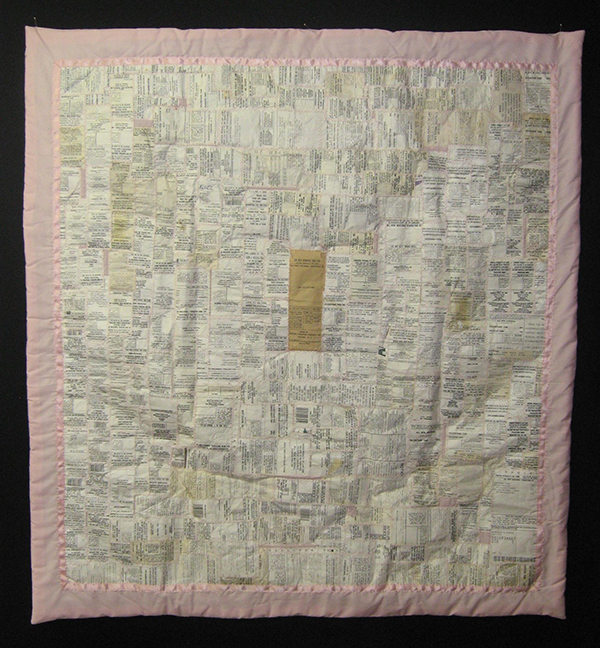
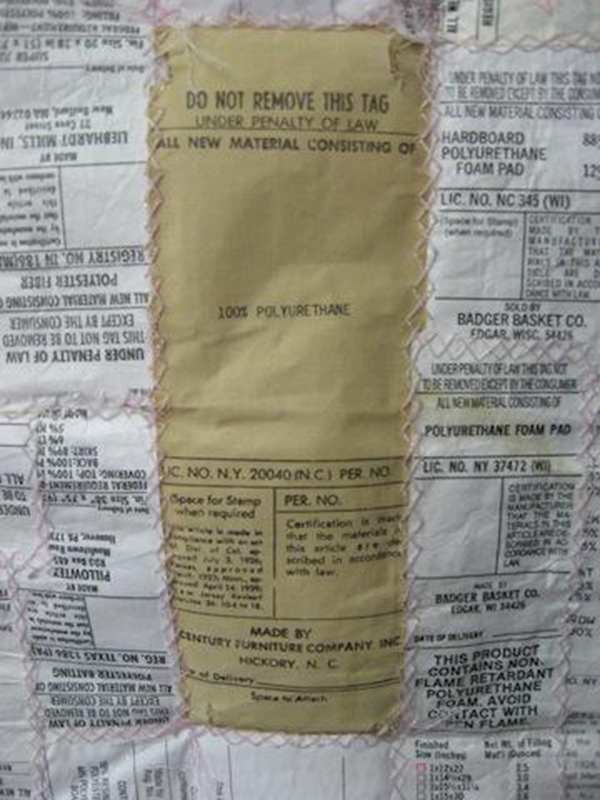
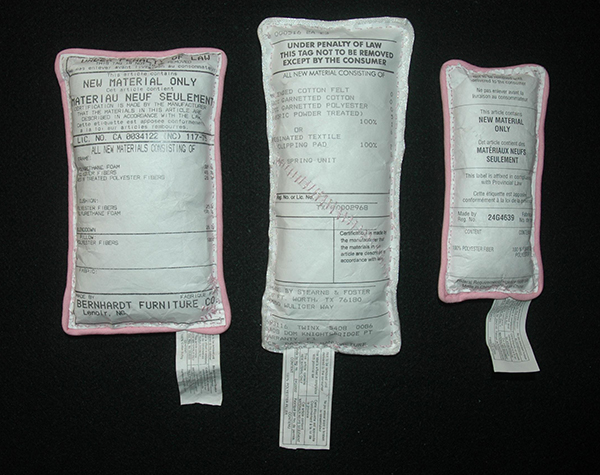
White Picket Fences by Amber Eve Anderson is a commentary on American domesticity and its literal unraveling. The innards or guts of a carefully constructed, knitted, white picket fence, stuffed into a suitcase, tell us that our domesticity is transient, portable and easily deconstructed.
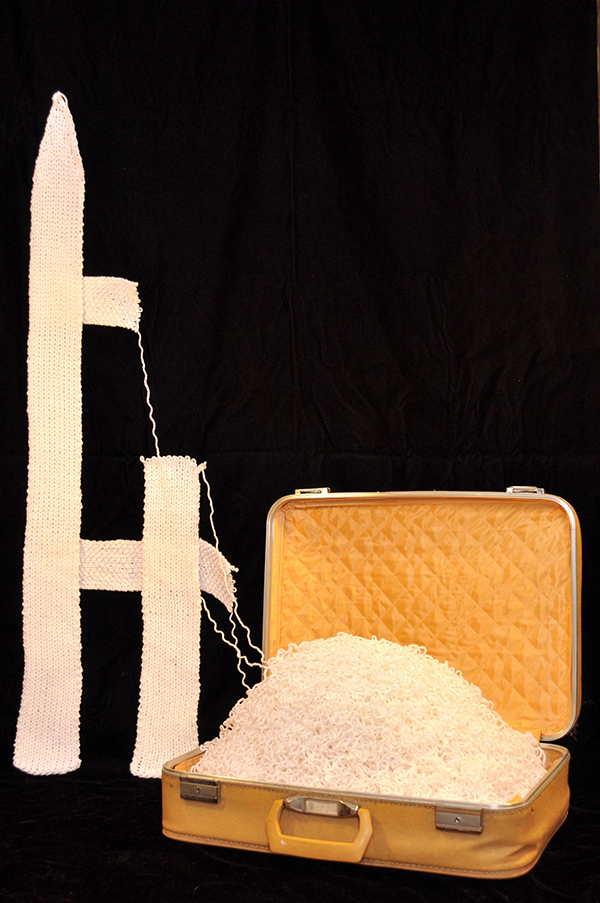
Jennifer Bolt’s Coded 2 is a weak attempt to depict connectivity merely by introducing fiber optic threads, which are a second thought. She could have exploited her use of materials to much more affect. Perhaps if she could see all the other work in the show she would go back to her studio with new insights to make her idea more convincing.
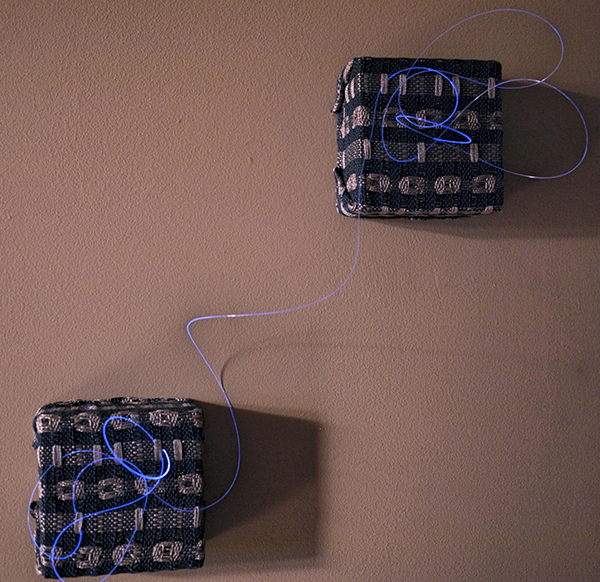
Kathryn Shinko’s The Heydrich Series: But We Thought You Wanted to Play With Us is beautifully crafted, whimsical embroidery on a photo of a serious man in a serious suit and pose. The juxtaposition of a domestic “woman’s work” in playful designs and colors and exposes society on numerous levels— male vs. female roles, children’s play vs. “real” work and so much more. This deserved an award because it is so simple, while simultaneously introducing so many ideas about our culture, including the value of “women’s work” or children’s play. The title adds another dimension and truly brings it all together.
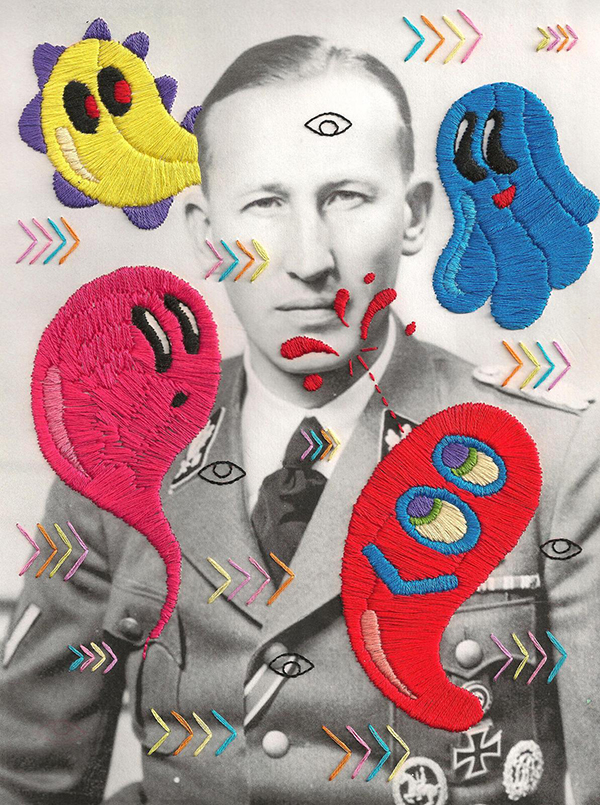
The top prize, Best in Show, went to It’s Heavy by Quinn McGill Palmer. I may not have paid so much attention to it had I not heard McIntosh’s comments about why he liked it so much. The insides of our intestinal system are realized with stuffed tubes of textured pinks and reds and use ‘tacky’ fabrics. The overall shape is that of a ball gown where the ‘innards’ should be the hoops and bustles while also referring to the guts of upholstered furniture. The fisherman’s sweater is masculine while the hooped skirt reference and choice of colors and materials are decidedly feminine.
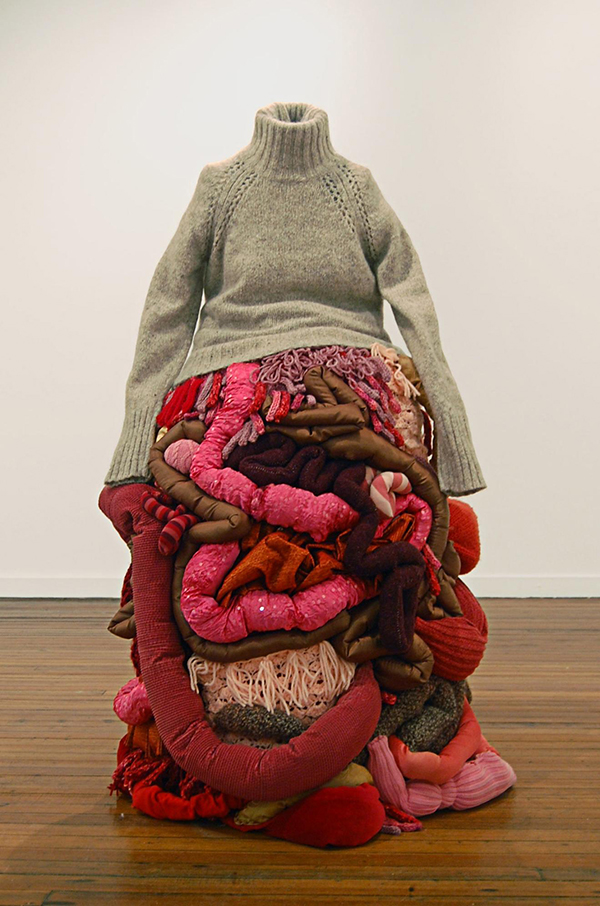
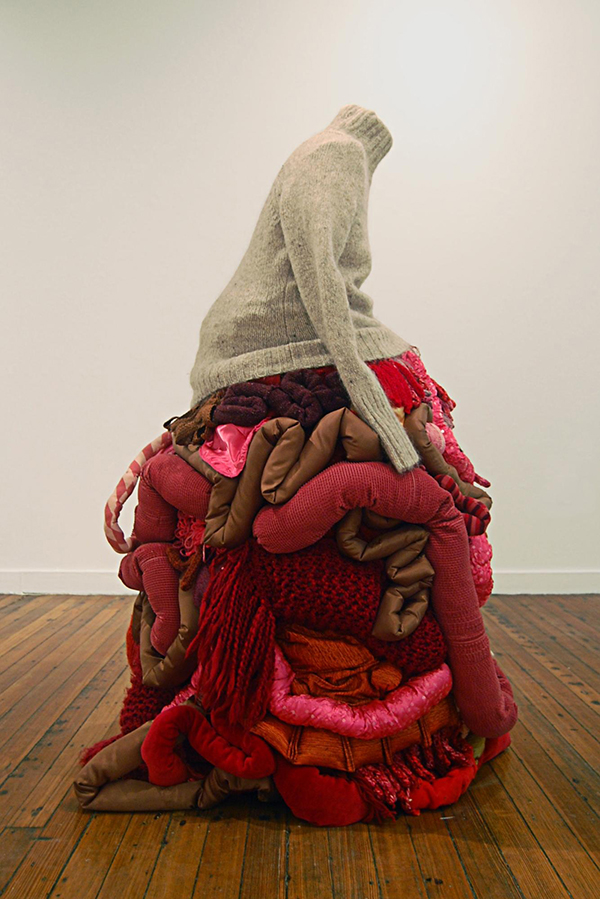
The selection of work in this exhibition supports the juror’s statement about the relationship between interior and exterior connectivity and referencing the history of Fiber Art. It gives us much to ponder.
It is out of the ordinary to show this type of thought-provoking work in Annapolis, where it may be least expected. Visitors to the galley, who have been using many of the techniques used to master the works hanging on the walls may see their “hand work” in a new light and come to realize that it can be more than the technique and the material, that they may have a concept to show and tell us.
The quality and content of the work at the MFA Gallery fiber show has greatly improved over the past few years and the number of artists who entered has increased. It is pleasing to see that this important art form, so vital, remains serious, thought provoking, relevant, alive and thriving.
Material Explorations A Nationally Juried Exhibition
Juror: Aaron McIntosh, MICA
July 18 – August 9, 2014
Maryland Federation of Art Circle Gallery
18 State Circle / Annapolis, MD 21401
www.mdfedart.com
Author Anna Fine Foer decided she was going to be an artist when she was 11-when she lived in Paris for a summer, visiting every museum and gallery. While a fibers/crafts major at Philadelphia College of Art (now University of the Arts) she became fascinated by the relationship between maps and the land they represent, embarking on a lifelong interest in maps and collage. After emigrating to Israel, Anna worked as a textile conservator in Haifa and Tel-Aviv. She studied at the Textile Conservation Centre, Courtauld Institute in London, where she received a Post-Graduate Diploma in Textile Conservation. Anna now lives in Annapolis with her two sons.
